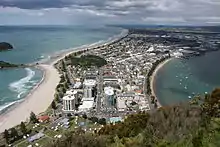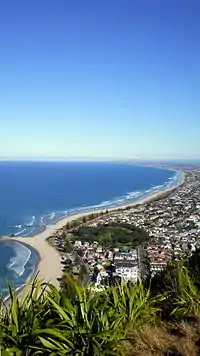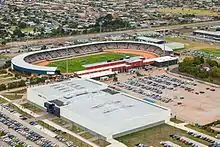Mount Maunganui
Mount Maunganui (Māori pronunciation: [ˈmaʉŋaˌnʉi], locally /ˈmɒŋəˌnuːi/) is a major residential, commercial and industrial suburb of the Tauranga metropolitan area, located on a peninsula to the north-east of Tauranga's city centre. It was an independent town from Tauranga until the completion of the Tauranga Harbour Bridge in 1988, which connects Mount Maunganui to Tauranga's central business district.


Mount Maunganui | |
|---|---|
Suburb | |
 Mount Maunganui Sunrise Aerial View | |

| |
| Country | New Zealand |
| Local authority | Tauranga |
| Electoral ward | Mount Maunganui/Papamoa |
| Population (2018)[1] | |
| • Total | 6,510 |
| Airport(s) | Tauranga Airport |
| (Bay of Plenty) | ||
| (Tauranga Harbour) |
|
Omanu |
| Matapihi |
Mount Maunganui is also the name of the large lava dome which was formed by the upwelling of rhyolite lava about two to three million years ago.[2] It is officially known by its Māori name Mauao, but is colloquially known in New Zealand simply as The Mount.[3]
The New Zealand Ministry for Culture and Heritage gives a translation of "large mountain" for Maunganui.[4]
Geography
Mount Maunganui is located atop a sand bar that connects Mauao to the mainland, a geographical formation known as a tombolo. Because of this formation, the residents of Mount Maunganui have both a harbour beach (Pilot Bay) and an ocean beach with great surf, within a short distance. At the base of Mauao, the distance between the harbour and ocean side is a couple of blocks.
The ocean beach has Mauao or Mount Maunganui at its western end, and a man made land bridge connecting Moturiki Island at its eastern end.[5][6]
Adjacent to Mount Maunganui on its south-eastern edge (from Sandhurst Drive onwards) is Papamoa Beach, another very large suburb of Tauranga. Papamoa Beach has a slightly larger population than Mount Maunganui, but doesn't have as many businesses as Mount Maunganui. Both suburbs are distinctly geographically separate from the rest of Tauranga by the Tauranga Harbour; two road bridges (SH2 and SH29) and a windy rural road (Welcome Bay Road) are the only feasible access ways to the rest of the city.
Mauao (The Mount) is a large lava dome[7] which rises above the town. According to Maori legend, this hill was a pononga [slave] to a mountain called Otanewainuku.[8] The conical headland which gives the town its name is 232 metres (761 ft) in height, and dominates the mostly flat surrounding countryside. It was formerly a Māori pā, and the remains of trenches can be seen in the ridges, as well as ancient shell middens. Today, it is open to the public year-round, and is a popular place to either walk around, or climb up. From the summit, a good stretch of coastline can be seen in either direction, as well as the Kaimai Range to the west.
Demographics
| Year | Pop. | ±% p.a. |
|---|---|---|
| 2006 | 5,334 | — |
| 2013 | 5,814 | +1.24% |
| 2018 | 6,510 | +2.29% |
| Source: [1] | ||
Mount Maunganui, comprising the statistical areas of Mount Maunganui North, Mount Maunganui South and Mount Maunganui Central, had a population of 6,510 at the 2018 New Zealand census, an increase of 696 people (12.0%) since the 2013 census, and an increase of 1,176 people (22.0%) since the 2006 census. There were 2,724 households. There were 3,264 males and 3,249 females, giving a sex ratio of 1.0 males per female, with 918 people (14.1%) aged under 15 years, 1,332 (20.5%) aged 15 to 29, 3,153 (48.4%) aged 30 to 64, and 1,101 (16.9%) aged 65 or older.
Ethnicities were 90.2% European/Pākehā, 13.3% Māori, 1.4% Pacific peoples, 3.2% Asian, and 3.3% other ethnicities (totals add to more than 100% since people could identify with multiple ethnicities).
The proportion of people born overseas was 20.6%, compared with 27.1% nationally.
Although some people objected to giving their religion, 58.8% had no religion, 32.1% were Christian, 0.6% were Hindu, 0.6% were Buddhist and 2.6% had other religions.
Of those at least 15 years old, 1,584 (28.3%) people had a bachelor or higher degree, and 675 (12.1%) people had no formal qualifications. The employment status of those at least 15 was that 3,090 (55.3%) people were employed full-time, 837 (15.0%) were part-time, and 141 (2.5%) were unemployed.[1]
| Name | Population | Median age | Median income |
|---|---|---|---|
| Mount Maunganui North | 3,267 | 44.3 years | $41,800 |
| Mount Maunganui South | 2,916 | 38 years | $43,100 |
| Mount Maunganui Central | 327 | 42.1 years | $35,800 |
| New Zealand | 37.4 years | $31,800 |
Politics
Over the years Mount Maunganui had suffered a number of attacks on its sovereignty by Tauranga but had fought fully and effectively to remain independent until the 1989 local government reforms.
During 1974 Bob Owens was Mayor of both Mount Maunganui and Tauranga, a unique situation in the annals of local government in New Zealand. Mr Owens made no secret of the fact that he favoured the joining of the two municipalities. The election of 1974 was fought on this issue and Owens was defeated in the polls in Mount Maunganui with a landslide victory to Mr L. Kelvin O'Hara, the youngest person elected to the position of Mayor in New Zealand,[9] who challenged him on the issue, and other environmental issues with the catch cry "why share a mayor?"
It remains controversial in Mount Maunganui whether the transition from an independently administered unit of local government to a minor part of the Tauranga City Council over 20 years ago was beneficial.
Some Mount Maunganui residents are still of the opinion Tauranga and Mount Maunganui are separate towns, even though they officially amalgamated in 1989. Simon Bridges, the local Member of Parliament for the area, described it in Parliament in 2012 "I have to say that there still is, though—and I have found this when first standing for Parliament—a sense of the "Mounties" and of those who are city-side, and that is still present to some extent"
History
Mount Maunganui was initially known colloquially as 'Maunganui' until 1907, when the name was rejected during the application process to name the area when the first subdivision of land was carried out; it was dismissed as being too similar to other towns' names. One of the early settlers, J. C. Adams,[10] then suggested three alternative names, which were Te Maire, Tamure (the Māori name for Snapper), and Rakataura, with the latter name selected by the Survey Department. The official name Rakataura never came into common use as Maunganui had long been the unofficial name of the town.[11] The name Mount Maunganui was a rebranding by early developers, changing it from Rakataura. The current name is an example of a tautological place name, maunga being a Māori term for mountain (nui means "big").
Mount Maunganui fought fiercely and successfully during the 1950s to retain independence from Tauranga, then failed with the completion of the harbour bridge in 1988.
The former Mount Maunganui Borough Council set records in New Zealand as having never had a deficit in its history, something which Tauranga City Council has never achieved. Critics say the town was built by leveraging the commercial and industrial ratepayers, but Mount Maunganui was a forerunner in some areas and applied the user pays philosophy before it was common in New Zealand.
The original early 1900s house of early settler J. C. Adams, the first home ever built at Mount Maunganui, still stands at 4 Adams Avenue. The circa 1906 house is registered with Heritage New Zealand as a Category II historic building.[12]
The local Whareroa Marae and Rauru ki Tahi meeting house is a meeting place for the Ngāi Te Rangi hapū of Ngāti Kuku and Ngāi Tukairangi.[13][14]
Character



Mount Maunganui is regarded by many to be a coastal resort town, although Port of Tauranga, a major facility, is also partly located on the western (harbour) side. It is also well known for the quality of its surfing conditions, though parts of the beach are notoriously dangerous. The harbour bridge was opened in 1988,[15] linking Mount Maunganui with Tauranga. The construction of a duplication bridge was completed in December 2009, forming a vital link in Tauranga and Mount Maunganui's growing motorway system.
A large container terminal and overseas wharf is located at Mount Maunganui. A branch railway from the East Coast Main Trunk railway runs between the Te Maunga and northern parts of the suburb.
Mount Maunganui also features the popular Bayfair Shopping Centre. The centre is one of the largest in the North Island outside Auckland and Wellington.
Mount Maunganui is a popular New Years destination, with over 20,000 people frequenting the suburb over the New Years period. Many festivities take place on and around the main beach in the north of the suburb.
As part of the Port of Tauranga is located in Mount Maunganui, there are many cruise ship visits annually to the suburb.
Sport
The suburb is home to the cricket ground Bay Oval, which held the 2018 ICC Under 19 Cricket World Cup final on 3 February 2018.
Every year Mount Maunganui hosts the Northern Regional Surf Championships (NRC's), and other events such as the NZ Under 14 Ocean Athlete Championships, the Pro Volleyball Tour and The Port of Tauranga Half Ironman triathlon.
Artificial reef
New Zealand's first artificial reef was installed at the Mount.[16] Construction of the reef was hampered by lack of funds and ironically, too many waves.[17] Initially the public was told the reef would cost about $500k,[18] but costs escalated to $800k,.[19][20] Media reported that local surfers are disappointed with the waves produced by the reef.[21] The reef has also been blamed for creating rips and has now been removed.[22]


Climate
The climate is mild subtropic:[23]
- Summer = 20 °C / 30 °C. ( Jan/Feb )
- Winter = 10 °C / 15 °C. ( Jun/Jul )
- Frosts Avg/Yr = 12 ( -1 °C −2 °C ).
- Rainfall = 1280mm/Yr.Avg
 Mount Maunganui Beach View From Top Of Mountain
Mount Maunganui Beach View From Top Of Mountain - Sunshine = Min 2200hrs/Yr.
- Beach Temp avg.
- Summer = 21 °C.
- Winter = 14 °C.
Education
Mount Maunganui Primary School is a co-educational state primary school for Year 1 to 6 students,[24][25] with a roll of 427 as of March 2020.[26]
Several schools are located in the suburbs of Omanu and Arataki, including Mount Maunganui College and Mount Maunganui Intermediate.
See also
- Mauao (Mount Maunganui)
- Mount Maunganui College
References
- "Statistical area 1 dataset for 2018 Census". Statistics New Zealand. March 2020. Mount Maunganui North (192800), Mount Maunganui South (193700) and Mount Maunganui Central (193900). 2018 Census place summary: Mount Maunganui North 2018 Census place summary: Mount Maunganui South 2018 Census place summary: Mount Maunganui Central
- "Mt Maunganui". Te Ara.
- The Mount from beach to boutique
- "1000 Māori place names". New Zealand Ministry for Culture and Heritage. 6 August 2019.
- http://ourcity.tauranga.govt.nz/heritage/legends/ Archived 23 February 2006 at the Wayback Machine
- "Sightseeing". Oceanside Resort & Twin Towers. Retrieved 22 October 2011.
- "Mt Maunganui". Te Ara.
- "Mount Maunganui: Mauao". AA Travel.
- "Mayor of Mount at 26". The New Zealand Herald. 14 October 1974. p. 1.
- Adams, C (8 May 1912). "Rakataura". Bay of Plenty Times. Retrieved 20 July 2012.
- Rorke, Jinty. "Western Bay of Plenty Street Names" (PDF). Tauranga City Libraries. p. 18. Archived from the original (PDF) on 3 February 2014. Retrieved 2 November 2012.
- "J C Adams Cottage". Register of Historic Places. Heritage New Zealand. Retrieved 2 November 2012.
- "Te Kāhui Māngai directory". tkm.govt.nz. Te Puni Kōkiri.
- "Māori Maps". maorimaps.com. Te Potiki National Trust.
- Harbour Bridge Heritage
- MountReef.co.nz Archived 28 December 2010 at the Wayback Machine
- Rowan, Juliet (8 November 2005). "Mount reef builders battle big swells". The New Zealand Herald. Retrieved 26 October 2011.
- Macbrayne, Rosaleen (18 June 2003). "Artificial surf reef needs wave of cash". The New Zealand Herald. Retrieved 26 October 2011.
- Macbrayne, Rosaleen (20 March 2004). "Mount missing the wave with artificial reef project". The New Zealand Herald. Retrieved 26 October 2011.
- Rowan, Juliet (25 September 2006). "Surf's up at the Mount – almost". The New Zealand Herald. Retrieved 26 October 2011.
- Ford, Joel (22 February 2007). "Artificial reef fails to win surfers' approval". The New Zealand Herald. Bay of Plenty Times. Retrieved 26 October 2011.
- Rowan, Juliet (3 January 2006). "Reef at Mt Maunganui a headache for lifeguards". The New Zealand Herald. Retrieved 26 October 2011.
- Local weather stations
- "Official School Website". mtprimary.school.nz.
- "Ministry of Education School Profile". educationcounts.govt.nz. Ministry of Education.
- "Education Review Office Report". ero.govt.nz. Education Review Office.
